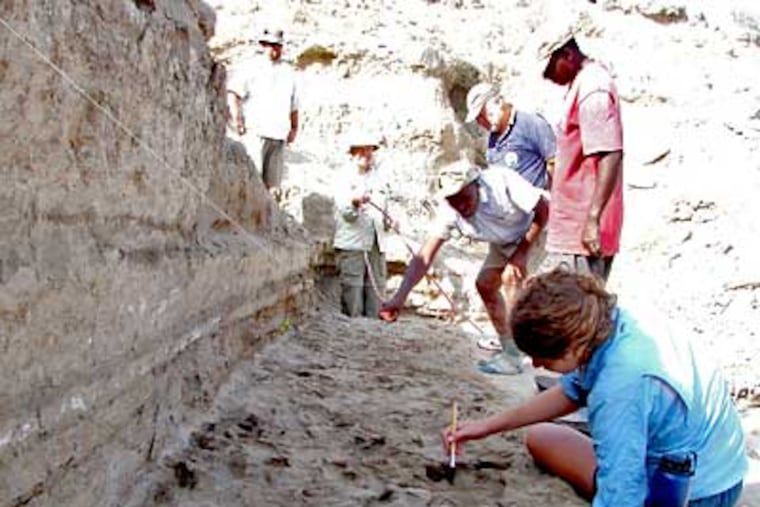Footprints offer clue on path to modern man
One and a half million years ago, a few of our ancestors walked beside a muddy African river with powerful, modern strides - a gait that let them forage over long distances, paving the way for evolutionary advances that make us human.

One and a half million years ago, a few of our ancestors walked beside a muddy African river with powerful, modern strides - a gait that let them forage over long distances, paving the way for evolutionary advances that make us human.
The evidence, reported by a team that included Rutgers University in today's issue of the journal Science, comes from the rarest of anthropological discoveries - their footprints.
Among those who helped uncover the tracks, preserved for the ages when a gently flowing river changed course and covered them with sand, were Rutgers undergraduates. Supervised by scientists, they used brushes to clear away sand bit by bit, retreating to their tents at night after days under the merciless Kenyan sun.
"You realize these are made by our human ancestors," marveled Andrew Du, now a senior at the school's New Brunswick campus. "It's a pretty surreal experience."
The find has set off a small debate over whether the creatures who made these prints - believed to be Homo erectus - are truly the earliest "modern" walkers, as the authors propose. Other fossils show that by the time of these footprints, our ancestors likely had been spending most of the time on two feet for millions of years.
Yet there is no doubt that the new prints are a rare find, and that the creatures who made them were spending not most, but all of their time on two feet, said Nina Jablonski, head of the anthropology department at Pennsylvania State University.
Their long, efficient strides would have allowed them to stray from the wood's edge, crossing open spaces to find other sources of food and possibly do some hunting, said Jablonski, who was not involved with the research.
This would in turn allow for the continued development of a larger brain - a process that already was under way as early humans spent less time in trees, freeing up their hands to accomplish more complex tasks.
Harvard University anthropology professor Daniel Lieberman said the arched, springy feet that made these prints could even have allowed their owners to run for long distances - the first appearance, perhaps, of a trait that makes modern humans almost unique in the animal kingdom.
"Looking at these footprints, I get very excited," said Lieberman, who also was not involved in the research.
The authors of the research first discovered what they thought might be footprints in 2005, while digging a trench to study the site's geology.
They noticed some curious deformations in a layer about eight feet down from the surface, and suspected they were seeing the cross section of footprints, said anthropologist David R. Braun, who is affiliated both with Rutgers and the University of Cape Town, in South Africa.
He and Rutgers professor John W.K. Harris enlisted the help of numerous others from Kenya, the United States, and Britain. The lead author of the paper was Matthew R. Bennett, of Britain's Bournemouth University, who captured three-dimensional images of the prints with a portable laser scanner.
This enabled detailed analysis of foot dimensions and the amount of pressure exerted by different parts of the feet. Harris said several characteristics set these feet apart from those of an earlier human ancestor, the short-legged Australopithecus afarensis, whose 3.7-million-year-old prints were found in Laetoli, Tanzania, in 1978.
First, the big toes in the new prints are pointed in a direction that is more nearly parallel to the axis of the foot, enabling a stride with a powerful push-off. (An ape's grasping, thumb-like big toe, on the other end of the spectrum, is splayed out to one side.)
Also, the arches in the new prints are more pronounced than those of the earlier Laetoli prints, Harris said.
One of the excavators of those earlier prints, Tim White of the University of California, Berkeley, questioned whether the feet of the two human ancestors were all that different. He said the authors of the new paper were overstating the supposedly "primitive" characteristics of the earlier A. Afarensis prints, making their new find seem more dramatic.
"The Laetoli foot is the foot of a biped," White said of the earlier prints. "It's a very human-like foot."
Countered Bennett: "It's all relative, isn't it?"
The new prints were dated in part by analyzing nearby bits of feldspar, a mineral formed by the cooling materials from a volcanic eruption.
The mineral contains potassium, which starts to decay slowly as soon as the material cools. The potassium decays into the element argon, which in turn is converted to another form of argon, said Braun, who graduated from Haverford College before getting his Ph.D. at Rutgers.
Scientists calculated the date when the mineral was formed by gauging how much of the decay had occurred.
The undergraduates who helped expose the prints included Rutgers students, among others.
Most of their food was in boxes and cans, brought in from Nairobi, but occasionally they bought goat or fresh fish from local people. The temperatures often exceeded 100 degrees, but any discomfort was outweighed by the thrill of discovery, said Du, the Rutgers senior. "It's basically an adventure," he said.
It is one he wants to continue after graduating. His planned career? Anthropology.